by
Caroline Zook
I have a caveat I’d like to start this article with: I’m not an SEO expert. I don’t do SEO for a living. Truthfully, thinking about SEO gives me a headache.
But, I’ve learned a few things along the way, most of which are from Matt Giovanisci, that are paying off, and I want to share them with you. Also, just so we’re both speaking the same language, SEO stands for Search Engine Optimization.
Some things you should know about this article before we dive in:
The data points below refer to my previous site JasonDoesStuff
I used to write and share an average of 50 articles per year
I spend almost no time on my SEO strategy
In 2014 my organic traffic (aka: Google traffic) was almost nothing
In 2015 I had about 60,000 visitors from Google
At the end of 2015 I started learning the basics of SEO
In 2016 JasonDoesStuff received over 200,000 visitors 😱
In 2017 organic traffic continued to over 320,000 visitors! 🤯
In 2018 JasonDoesStuff became this site
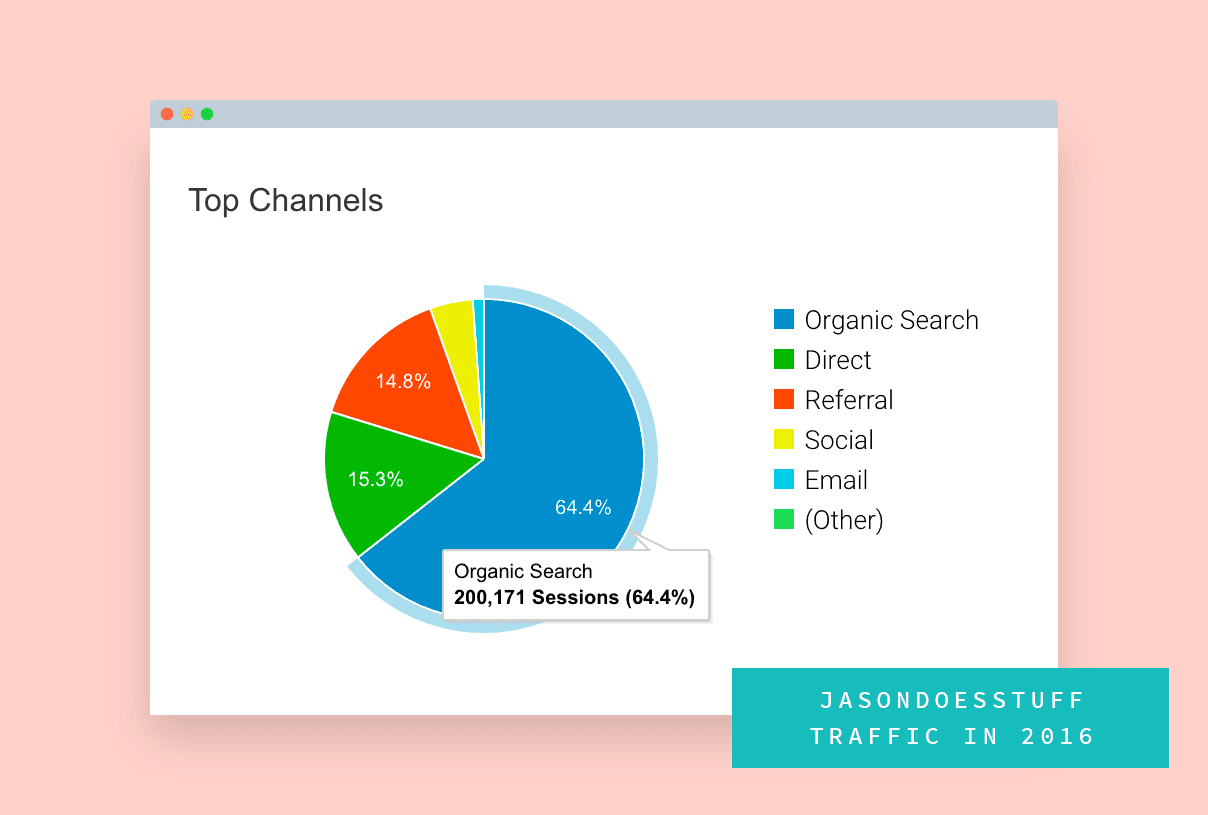
I’m going to share every single SEO strategy I know with you in this article. Most of the things I’ll walk you through will seem super obvious and easy. This isn’t rocket science folks, it’s just setting your content up to be read correctly and efficiently by search engines.
TL;DR—How you can start winning at SEO right now:
Write useful and/or entertaining content
Find your focus keyword (meaning the most important term in your article), and use it in your title (H1), headings
(H2/H3/H4), and throughout your post
Research words or terms related to your focus keyword, and pepper them throughout your post
Check back in semi-regularly to update your post (you may need to wait 6-12 months)
Make sure your website looks good on mobile and loads quickly
Ready to venture into SEO-Land? But you know, not super confusing and overwhelming SEO-Land? Let’s do it!
SECTION ONE:
Let’s Get The SEO Elephant Out Of The Room
Elephant: Your SEO focus shouldn’t be about gaming some keyword or trying to grow traffic based on a hot topic. Your SEO focus should be on writing content that is useful or entertaining.
Now that we’ve gotten that outta the way, let me remind me that SEO stands for Search Engine Optimization. It does not stand for Search Engine Do-Something-Once-And-Never-Touch-It-Again-Ever.
Google, and other search engines (Bing, Yahoo – LOL, etc), want things to be kept up to date. They want your site design to improve how your content is delivered. They want to make sure your site looks good on mobile devices. They want you want to add helpful updates over time to content you’ve written. This does not mean you’ll have to spend hours every week slaving away on your articles. It simply means you’ll want to check in from time to time and ensure the content you wrote months or years ago is still relevant. Hence, optimization.
SEO glossary of common terms/acronyms
While we’re covering our bases when it comes to SEO, let me also explain a few pieces of the SEO-puzzle that you may not know about (or have heard of them, but feel completely lost):
The “H” in H1, H2, H3, etc simply stands for “Heading”
H1 – You should only have ONE H1 in your content and it should be the title
H2 – Think of H2s as section headings (or chapters in a book)
H3 – Think of H3s as sub-headings (or sub-chapters in a book)
H4 – Think of H4s as headings that highlight an important point
H5/H6 – Much less important and relevant headings
Keyword – The one word you’d use to explain the topic of your article
Key Phrase – Similar to the keyword, but usually more than one word
Title – The title of your article and SHOULD be your H1 tag as well
Description – A short paragraph that describes your article (and has the keyword/phrase in it)
Now we’re on the same page with all the fancy acronyms, words, etc, right? Cool. I’ll talk more about a few of those in later sections of this guide (specifically keywords in Section 3). Moving onto the fun stuff…
How I accidentally started ranking #1 for a search results that brought 100,000 pageviews in 2016
We’ll need to hop in our content-writing time machine and go back to 2014. It was nearing the end of that year, and I was feeling completely fed up with social media. I spent every day scrolling through my Facebook feed. I invested way more time than I’d like to admit trying to come up with witty things to share on Twitter. More than 75% of my day was spent in the dark catacombs of social media.
I decided it had to change. I imposed a 30-day social media detox and wanted to see what would happen if I didn’t log in to Facebook or Twitter for a month. You can read the results of my social media experiment here.

(I purposefully removed pages 2-5 for an easier viewing experience—you’re welcome!)
The article I wrote about that experiment ended up ranking #1 in Google for the phrase “social media detox,” which brought almost 100,000 pageviews to JasonDoesStuff.
The four steps I used to get 100,000 pageviews from Google
Step 1: I spent six years building a name for myself on social media.
Step 2: I did something interesting (and maybe a little drastic) in announcing my 30-day detox, and then spent at least an hour per day, for 30 days, writing about it (which would end up in one long article).
Step 3: I stuck with the 30-day detox and the daily writing, and compiled my results into one well-organized article.
Step 4: I published the article it in November 2014, shared it a few times, and then completely moved on with my life.
You may notice that none of those four steps involved SEO. I didn’t have a WordPress plugin that did the SEO work for me (although I now love Yoast and will talk more about it in a minute). I didn’t have someone optimizing my site for SEO.
I literally did NOTHING to optimize my article for search results, other than try to write a useful and entertaining article based on my life experiment.
Which brings us back to a point from the beginning of this article and the first lesson I want to impart on you about SEO…
SECTION TWO:
The Best SEO Strategy Ever: Write Helpful Or Entertaining Content
I am sure some SEO “experts” have a much better plan than the one I’m about to lay out for you. That’s great for them. If you know an SEO expert, please tap them for their knowledge, and start implementing their tactics right away. I’ve heard great things about Moz, but I have never read a single article of theirs.
Don’t focus on the “O” in SEO until you have content to optimize
When my social media detox article started getting increased organic traffic, I decided it could be beneficial to figure out why and reproduce those steps. You know, build an “SEO strategy.”
When you start seeing a little bit of traffic, that’s when it’s time to OPTIMIZE!
The most important thing for me was making sure that my SEO efforts weren’t going to feel like a ton of extra work. Getting more traffic from Google can be a full-time job, and that’s not what I wanted to spend my time doing.
Here’s an additional thought from my friend Matt about not starting with SEO:
“It’s called SEO for a reason. You’re optimizing something that already exists, not creating something starting with optimizing. So it makes sense that you write things with no SEO plan, then if it takes off, you SEO the hell out of it for the best possible results.”
My current SEO strategy that I hope you steal with pride!
Here’s what my current SEO plan looks like, which has helped me grow my organic search traffic from 0 visitors to 200,000 visitors annually:
Have an article topic that I’m very interested in writing about and that I have personal experience with
Write that article, and have my editor make sure it’s not complete crap
Once the article isn’t crap, identify the main keyword or phrase
Search my keyword in SEMrush.com or Ahrefs and identify related keywords
Input my keyword or phrase in the article title (H1 tag), and headlines (H2, H3, and H4), and include the keyword in a bolded or italicized sentence
Write a simple headline (we’ll talk about good headlines in a minute) and short description that is NOT clickbait-ey (this is usually the H1 and H2 of my article)
Use the H1 and H2 in the Yoast SEO plugin in WordPress
Publish, share, and update the article when necessary
Those eight steps can be a bit much to digest in a numbered list. Since I care about you, I’m going to break each one down a bit further (with graphs, charts, and supporting PNGs for all you visual learners out there—yay!)
SECTION THREE:
Your Simple 8-Step Plan To Increase Website Traffic
Step 1 to increasing organic traffic – Find an article topic you actually care about
Notice I didn’t say “find an article topic you can rank for.” That’s a losing game. Chasing keywords based on what you could rank for may work in the short term, but you’ll very quickly get tired of writing content if you don’t care about the topic.
Have no clue what topics you should write about? Answer these questions:
What do you enjoy doing in life or business?
What experiences and stories do you have that you can share lessons from (like this article!)?
What do you get asked about the most often?
What have you written about before that you can add new perspective to?
Once you have a topic to write about, be realistic about your expectations when it comes to getting organic search traffic.
For instance, this article you’re reading now barely has a chance at ranking for the keyword “SEO” or phrase “SEO Strategy.” Even knowing that, I kept getting asked about SEO strategies I use because I’ve shared in the past that my organic traffic has grown exponentially. That reason was compelling enough for me to spend over 40 hours creating this article (not an exaggeration). Whether this article ends up getting organic traffic from Google doesn’t matter, as it’s content I wanted to share!
Next, use a simple content calendar to keep your content creation consistent:
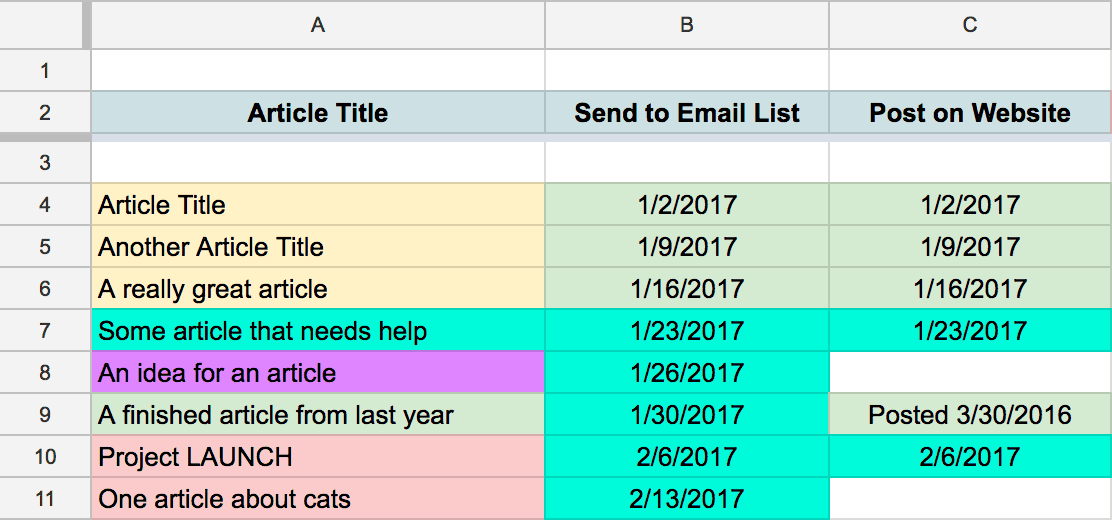
As far as a content calendar goes, I have a very simple Google Spreadsheet I’ve created. I use this on a weekly basis to schedule upcoming articles and keep track of previous articles. You can use my template by clicking here and making a copy (File > Make a copy…) or downloading that sheet as a PDF.
Bonus tip to finding article topics: If you still have no interesting topics to write about after trying to answer the four questions above, text five of your friends and ask them, “What’s something you think I could write an article about?” You may get weird answers, but you may also get fodder for content!
Step 2 — Start ugly and then invest in your writing (aka: hire an editor!)
When I started writing consistently (one article per week) in 2014, I didn’t have an editor. I did have a helpful wife who could review my writing and make sure it wasn’t littered with typos, but we were both busy, so she didn’t always look at my articles before I hit publish. I started ugly.
The first articles you write, or maybe even the articles you’re currently writing, aren’t going to be great. In fact, they might suck.
It’s okay if your content sucks in the beginning! Most of my early articles weren’t very good, and I’m ashamed of them now.
I didn’t have a single article getting organic search traffic before my social media detox article. Instead, my articles got published each week, got read by a handful of loyal readers, and that was it. You may be in the boat I was in in 2014. Again, that’s okay! Sit in your boat (at your desk). Grab your oars (your computer). And just keep rowing (writing).
Remember Step #1? If you’re writing about things you enjoy writing about, don’t worry about getting organic search traffic.
Worry about writing something useful or entertaining.
When your writing does start to get better and starts to bring you results (whether that’s organic search traffic or sales for your business), it may be time to invest in an editor.
It wasn’t until I’d been writing for 14 months, nearly 90 articles and 800,000 words later, that I decided to start paying an editor.
Now, my editor, Chantel Hamilton, is someone I gladly pay to help my writing be as good as it can be.
It may be hard to figure out when the time is right to invest in an editor, but if you’re anything like me and your writing is the driving force of your business, now might be the right time to find a good editor.
Pro-tip: If you’re looking for a great editor, reach out to people you know who write frequently and probably use an editor. You can also reach out to Chantel Hamilton to see if she’s available. If she’s not, she may have someone to refer you to.
Steps 3 & 4 — Identify the main keyword(s) or phrase(s)
Let’s take a trip to Exampletown!
I wrote an article about my experience failing the workout system P90x. If you want to read that article you can do so here, but the gist of it is that P90x isn’t made for everyone, and you need to find the workout system that works best for YOU (which is the same lesson I’ve learned about business, too).
When I originally wrote that P90x article in early 2015, I hadn’t spent a minute thinking about SEO (or the 8 steps I’m outlining here). However, I really enjoyed the message in that article, and my audience seemed to enjoy it as well. I decided it was time to revisit it in August of 2016.
In August of 2016, I remember searching “P90x” in Google and clicking through pages upon pages of results. After about the 9th page of results (who goes that far?!), I finally found my article. However, I noticed something: my headline and description result in Google sucked.

My previous title was: Learn From Failing P90x Too*
My previous description that Google pulled in was: I completely failed at trying to do P90x. But in that failure, I learned some valuable lessons.
*Because of how my blog posts were set up in a previous version of my WordPress website, the title was broken between two separate H1 tags, which is a big SEO no-no. The other H1 tag on my site said “I Want To Help You…”, and Google pulled the second half to come up with this crappy and incoherent headline.
The only saving grace for both the title and the description was that they both had the main keyword in them (by accident, obviously).
So I had this article that I was ready to optimize, what did I do first?
I started by clearly identifying the article keyword and related keyword…
The Keyword: P90x (duhhh)
The article was about my experience with P90x, so P90x, naturally, was the keyword. If you’re struggling to identify THE keyword in your own articles, here are a few questions to ask yourself that might help: When reading your article back, what’s the one idea or thought that stands out? Is there one WORD that the article is really about, like the hero of the story? What’s the hero’s name? That’s your keyword.
The Related Keyword/Phrase: P90x schedule
I found the related keyword by using SEMrush.com (I use the free version of SEMrush, by the way). After creating a free account, you can search your original keyword and find other keywords or phrases that are similar and relate to the content you’re writing about. For my article, the phrase “P90x schedule” made sense, and the volume of searches was high enough** to be worth trying to squeeze the phrase into my article.

**The volume of searches of a keyword or phrase was something my friend Matt explained to me. It’s unlikely you’re going to rank on the first page of Google with a keyword that has a very high volume (P90x has 110,000 searches), but, you also want to pick the phrases that make sense in the content you are writing about. Focus on keywords with volume of 500 – 5,000 for best chances of winning at ranking for that keyword. I ended up choosing a higher volume related keyword (P90x schedule), but it made the most sense within my article.
After I clearly defined the focus and related keywords (P90x and P90x schedule), I revisited my crappy article title. Luckily, my JasonDoesStuff website had been redesigned (twice) since writing the first article and I no longer had a weird split H1 title tag.
The new title I wrote was/is: I Failed P90x and Here’s What You Can Learn From My Experience
The new description was/is: P90x isn’t for everyone. I only made it to P33x, but I did learn a bunch of lessons along the way about life, business, and the P90x schedule***.
***You’ll notice the keyword AND related keyword/phrase are now both in the description. SEO bingo!
I didn’t use it at the time, but as I’ll talk about more in Step 6, the Headline Analyzer tool showed me the difference in score between my previous P90x headline and the new one:
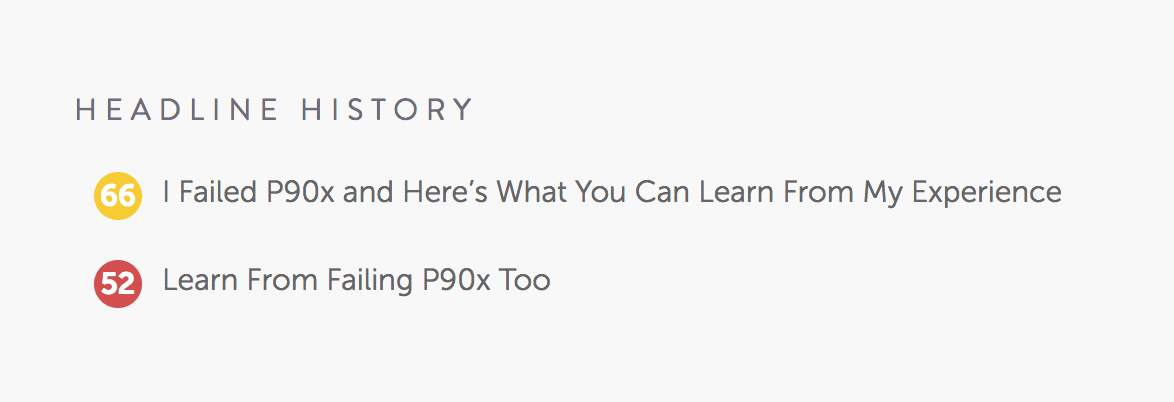
All of this stuff is great, but what did this SEO work actually do for increasing my position in Google’s search results for “P90x”??

Yep! I went from a search result position on Page 8 (90ish) in June of 2016 to Page 2 (result #20ish) in March 2017. The search keyword “P90x” is now the 10th organic search keyword on my site, whereas it wasn’t in the top 50 results in 2015 or 2016.
Step 5 — Use your keyword and related keyword throughout your article
My previous thoughts of SEO were: Slap a keyword in the title and, boom, I’m off to the SEO-races! You’re welcome, Google.
Doesn’t quite work that way…
Without having your article read like a repeating-parrot wrote it, you want to include your keyword or related keyword/phrase within all the headings (H1*, H2, H3, H4) and important text (bold, italics, etc).
(Important reminder: You should only use ONE H1 tag per page. If you’re currently using an H1 more than one time in an article or page, you could be getting penalized by Google.)
Note: If your website articles aren’t currently set up with the heading structure I share here, you may need to revisit the styling of your articles and how your headings are being used. Google DOES care about the use of H1, H2, and H3 tags so get your article foundation set up correctly!
If we go back to my P90x article (which you can reference here), here’s how I shoe-horned the keyword in throughout the text of the entire article:
H1 (title) — I Failed *P90x* and Here’s What You Can Learn From My Experience
H2 (first paragraph) — I completely failed doing *P90x*. But in that failure, I learned some valuable lessons about life and business.
H3 — When I popped the first DVD in, starting my *P90x workout schedule*, I expected to start at P1X; Day one.
H4 — Just because another business or person can do something the *P90x* way doesn’t mean that’s the only way it can be done.
Bolded text — So I stuck with Tony and his *P90x workout schedule*. For 33 grueling days, I shoved DVD after DVD into the black box on my TV stand, and I did my “best” and tried my hardest to “forget the rest.”
(The *asterisks* are there just to show you the keywords, they don’t actually exist in the headings or text.)
Reading these headings without the context of the article seems very repetitive and sometimes you might feel like you’re overdoing it with your keywords/phrases. I can promise you that you are not and that Google and the people that read our articles are not reading every single word, sentence, and paragraph.
Setting up keyword/phrases in your headings and throughout your article itself reaffirms the importance and relevance of the keywords and phrases as a reader consumes your content.
What about keyword research? Here’s a real-world example from my buddy Matt of what happens when you find an odd keyword:
“When you do keyword research, you might find weird phrasing. Like, one keyword I was trying to target was ‘sand in pool.’ No one says it like that, but it’s the number one searched phrase for that topic. I had to ignore it, and I went with ‘sand in your pool.’ Still ended up ranking for the keyword!
Or you can get clever, like: Sand in Pool? My 5 year old found sand in our pool, and this is what he said.”
Going through the heading tags and optimizing text with keywords and related keywords is incredibly useful for articles you may have already written.
Like my P90x article, you may have a piece of writing that isn’t ranking at all, but that you enjoy and should be getting more reads. Spend the time to go back through your article and inject your keyword and related keyword (optimize!).
Step 6 — How to write a great headline (or article title)
I want to preface this section by saying I haaaaaaaate clickbait headlines.
37 ways to use cinnamon to sell digital e-books!
This guy lost 200 pounds using only paperclips!
You’ll be shocked at what 12 mountain goats can teach you about business!
Yeah, those headlines? They suck. Even though some sites generate a lot of traffic using clickbait headlines, it’s not something I ever want to do with my content. Plus, have you ever clicked on one of those articles? It’s always a dumpster-fire of information.
Instead of writing a garbage headline, why not write one that goes along with the useful or entertaining content you’re writing?
I genuinely enjoy the challenge of writing a compelling headline for my articles. However, I know that most people don’t. Enter: CoSchedule’s Headline Analyzer tool. I love how simple this tool is: just pop in your headline, and it gives you the score based on some fancy algorithm. The color-coded scoring is really helpful when looking at a list of 10+ headlines (as you’ll see below) to see what ends up being green. (And green is good!)

As you can see above, I wrote out 10 different headlines for this article. The one I ended up using (Everything You Need To Know From My Experience With SEO) was the highest ranked (score of 77). However, if I’m using a headline analyzer tool, I do so with a grain of salt. I’ve picked headlines that get scores in the high 50s or low 60s, because I liked those headlines the best.
Like all tools, CoSchedule’s Headline Analyzer isn’t perfect—it may weigh headline scores based on headlines you don’t actually want to have on your site. But it is free (just sign up for an account) and it is super helpful if you have a hard time writing headlines for articles. Use your discretion to pick headlines that score well with these tools, but that also feel like something you’d write (and that your audience would resonate with).
Step 7 — If you use WordPress*, immediately install and use the (free) Yoast SEO plugin
I’m not a huge advocate of WordPress plugins because they can very quickly make your site slow to load, which Google doesn’t love. That being said, the SEO plugin from Yoast is a true diamond in the rough.
(If you haven’t noticed, every tool I’m recommending in this article is free. The Yoast SEO plugin joins the free-and-awesome club. Yay saving money!)
Simply search for the Yoast SEO plugin in your WordPress plugin dashboard or however else the kids are adding plugins these days. Once installed, you can spend time messing with the advanced settings, but I haven’t. Nor have I spent a moment looking at the upgraded features of the paid version of the plugin. Just use the free version, k?
This is how the Yoast SEO plugin works: it hangs out at the bottom of your article and you enter your Title, Description, and Focus Keyword. As a reminder, my H1 is my Title, one of my H2 or H3s is usually my Description, and you know all about the focus keyword by now.
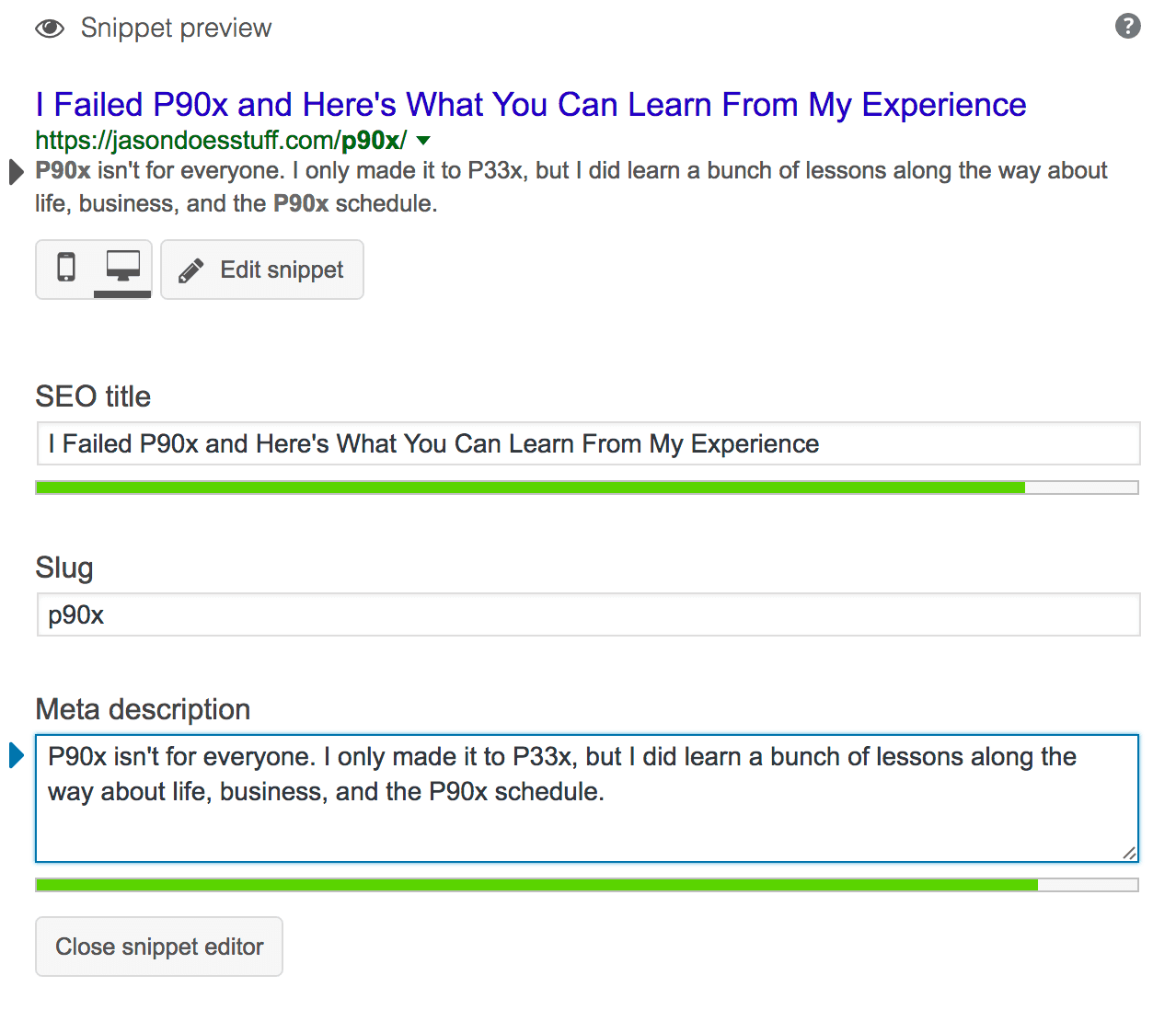
The great thing about the Yoast plugin is that as you put in your title, description, keyword, and save your settings, it will give you colors telling you how you’re doing (green = good, yellow = okay, red = needs improvement).
Here’s a helpful note from Matt regarding URL slugs:
“If you change the slug (the /name of your URL), you should use a redirection plugin to forward the old slug to the new slug so you keep the SEO juice flowing and there are no 404 page errors.”
The rest is SEO magic. Truthfully, I have no idea how Yoast works or what it’s actually doing to help Google better find my articles. But, it’s working, and when I get all the green dots and lines from Yoast, I know I’m good to go.
Yoast note: I tend to not pay attention to the “Readability Score” that Yoast gives me. My social media detox post, the one that generated nearly 100,000 pageviews in 2016, has red flags, and I’ve never even read what they are. Your article should be readable, which is something you can discern on your own.
*If you don’t use WordPress… well… shame on you! No, just kidding. But I only use WordPress, so I don’t have any recommendations if you use Squarespace, Wix, Weebly, Webflow, or whatever other weird website building tools you’re using.
**If you want to read an in-depth guide to using and setting up Yoast SEO, this is a really good one!
Step 8 — Publish, share, and optimize your article when necessary
As I mentioned at the very beginning of this SEO fairy tale, I don’t like to spend a ton of time thinking about SEO. Once I do all the steps laid out here, I have a very in-depth article sharing strategy that looks like this:
I share the article via my Twitter account (if I remember)
I email the article to my email list (most of the time)
I live my life
Yeah, that’s it.
SECTION FOUR:
What About Backlinks? Are They Important?
As you can probably tell by now, I don’t subscribe to all the standard SEO rules. Sure, I use the foundational elements, but I’m not doing ALL. THE. THINGS. That being said, there’s one big topic when it comes to SEO that has a lot of gray area.
Enter backlinks: Should you care?
Simply put, a backlink is a link that someone else puts on their site linking to your article. My social media detox post, which brought in over 150,000 total unique visitors in 2017, only has 59 total backlinks.

To me, that’s proof that backlinks are NOT of paramount importance. Maybe a few years ago they were, as many SEO experts/gurus want to tell you, but I have the data to prove backlinks aren’t the end-all-be-all of SEO.
Backlinks, and the entire process of trying to convince other website owners to link to my content, just isn’t something I want to waste a single second on. Could it help me? Could getting backlinks take my organic search traffic to 10x of what it is right now? Maybe… but at what cost? I don’t want to use the tactics it takes to get people to post links to my articles on their sites.
Want people to link to your content? Write great content!
Do I sound like a broken record at this point?
I’ve found that people are way more receptive to linking to your content when they find it on their own or when someone (usually a friend) recommends it to them. You can’t force that. You can’t use some fancy software to trick people into having that happen.
Instead of spending any time trying to convince other people to do things, spend that time improving your writing. Spend that time writing in-depth content like this article that can actually help people.
So, you get it now, right? I don’t worry about sharing and backlinks and all that jazz. I share minimally and still get rewarded by Google for writing good content. Does it sometimes take a year or two? It sure does. But there’s no 2-Day Delivery option for the first page of Google (thanks for nothing, Amazon Prime!).
SECTION FIVE:
Why Page (or Site) Speed Matters And How To Improve Yours

I wanted to write up a really witty section headline about Keanu Reeves and the (fantastic) movie Speed. Alas, I didn’t, so instead, I just grabbed a GIF of Keanu and we’re moving on with more helpful SEO advice.
I’d never ever run a speed test on my website before January 2017. My version of a speed test was loading my own website and thinking, Hmmm, that loaded slowly…oh well!
My friend Ben Rabicoff introduced me to the world of Google PageSpeed Insights, GTmetrix, and Pingdom. I want to make it SUPER CLEAR that I do not have a list of easy ways you can improve your site speed, because that’s really subjective and based on your specific website configuration. That being said, all three tools (Google PageSpeed Insights, GTmetrix, and Pingdom) will offer suggestions after they scan your website on how to improve the speed.
(Ben, you may not have actually intro’d all of these to me, but you get credit, so enjoy it!)
I would imagine you know which one of these page speed sites you should make happy first?
You said Google PageSpeed Insights, right?
Yes, you did, because you’re smart and you know you want to make the Google-Gods happy first. But I will drop yet another caveat on you: it’s good to strive for a high score, but getting a higher page speed score does not directly correlate to getting more organic traffic (as I’ll share in a moment with my friend Paul’s site).
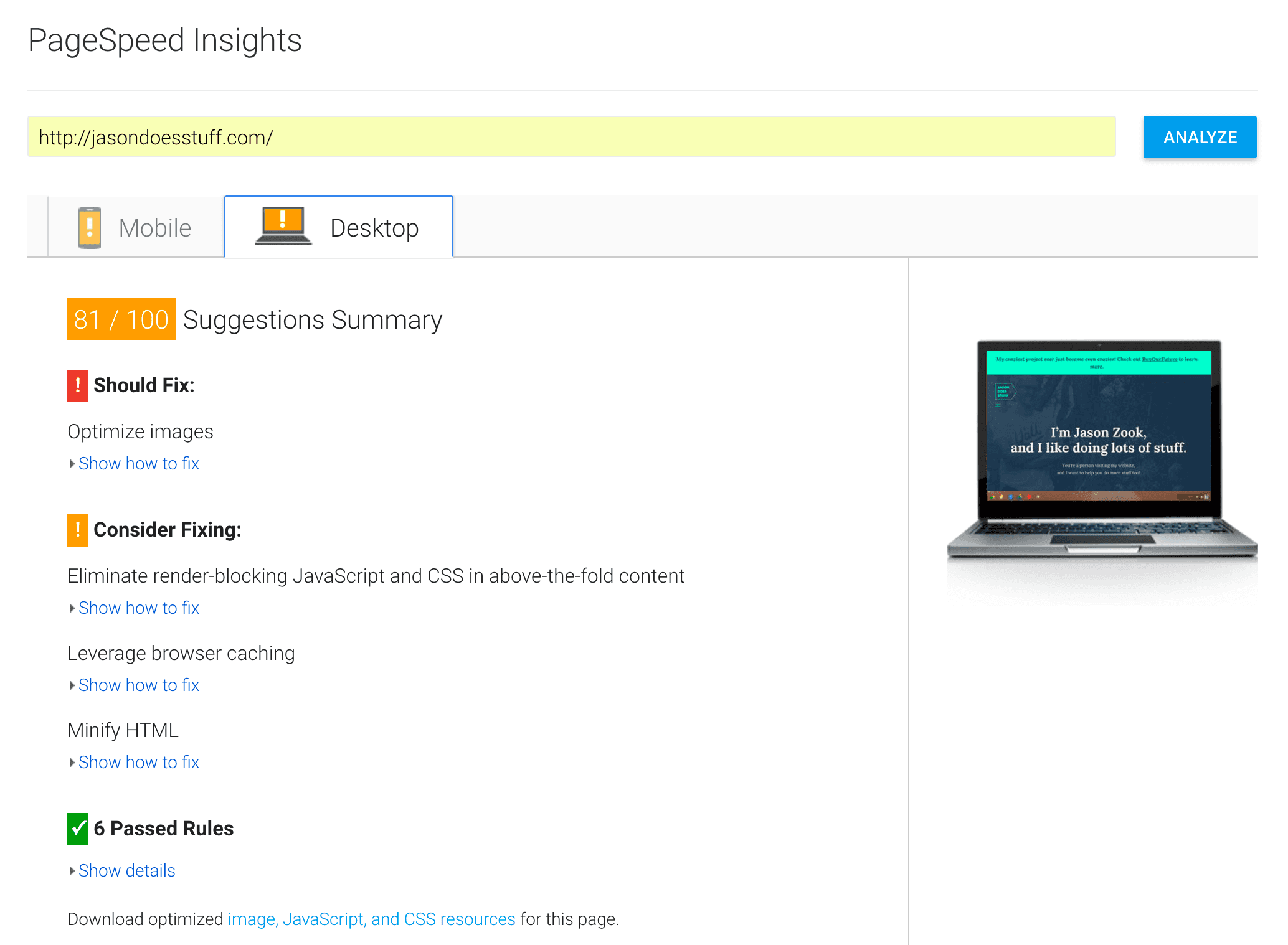
This is where I show you how un-perfect my previous website’s PageSpeed score was according to Google’s tests. I could go into detail as to why these scores aren’t totally accurate, but we’ve already spent so much time together in this article. Let’s just say that my buddy Ben helped me do all the right things to optimize JasonDoesStuff for speed, but there were a few flags we couldn’t get Google to ignore.
Your site speed is important, but it’s mission critical
Even with my not-so-perfect PageSpeed score, I wanted to show you how that score doesn’t totally impact Google sending organic traffic your way.
The two delicious pie charts below show my JasonDoesStuff site (left) versus my friend Paul Jarvis’ site (right). We get fairly similar overall traffic numbers, but Paul’s site ranks 87/100 on Google PageSpeed Insights (while my site was a paltry 81/100). My lower page speed score hasn’t affected my Organic Search being a higher percentage of my traffic than Paul’s.
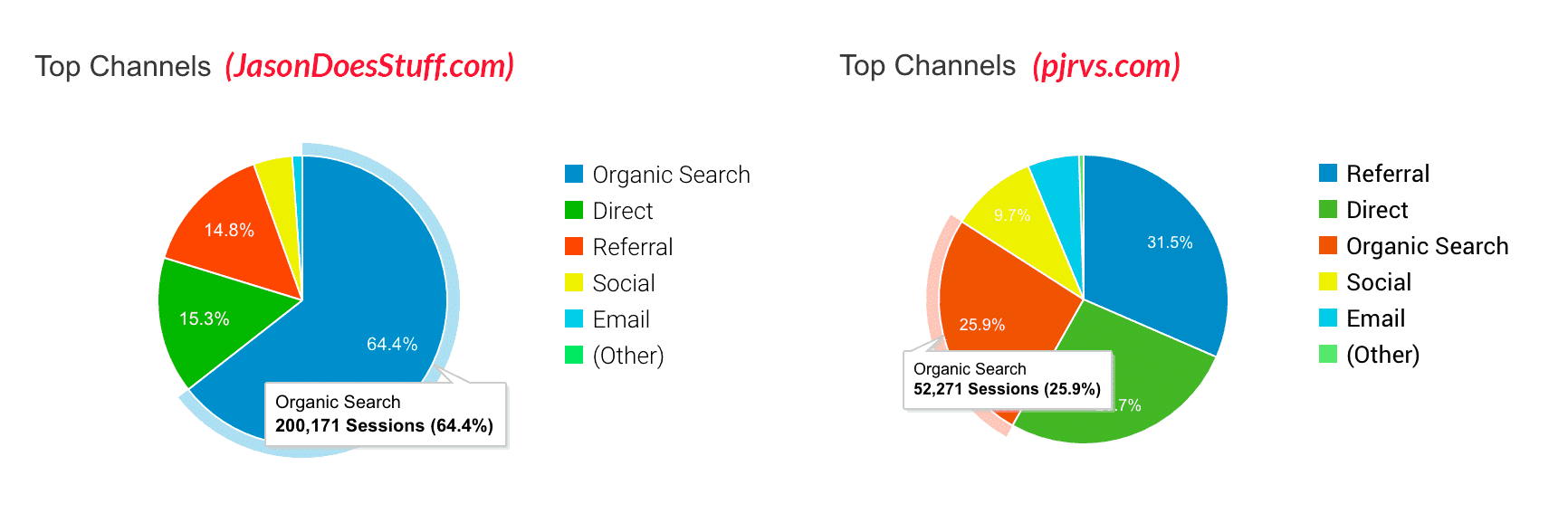
I promise I don’t bring this up to gloat, I bring it up because you don’t have to have a perfect page speed score to have your site rewarded with solid organic traffic. Google still wants to display the best content it can find, even if the site doesn’t load as quickly as a cheetah (Google’s okay with wounded hippo speeds, too).
Let’s look at a second page speed site, GTmetrix…
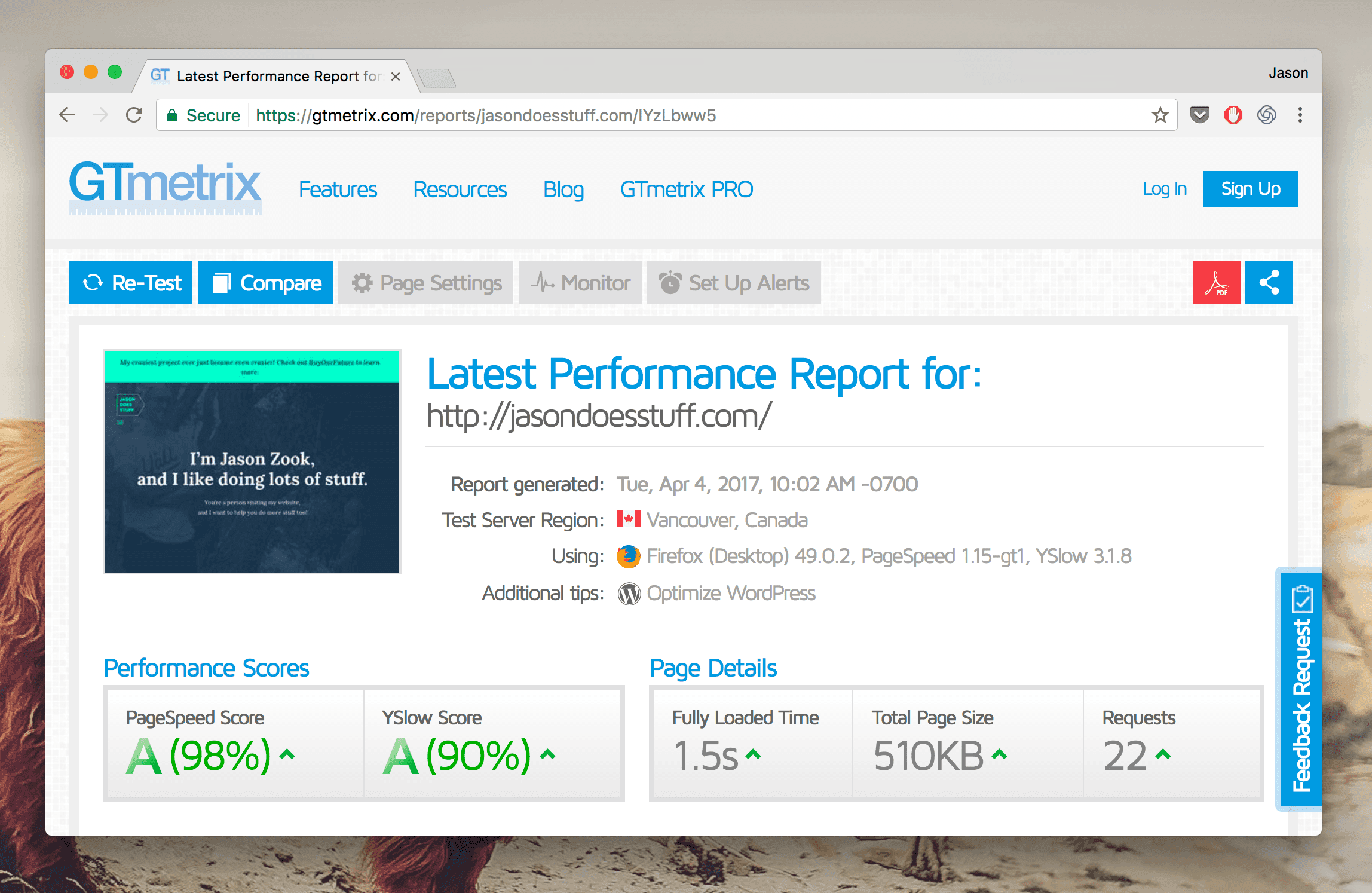
Testing your site with a second page speed tool is kind of like going to a doctor for a second opinion. Yeah, you totally trust the first doctor (Google), but jusssst in case he’s having an off day, you get that second, younger doctor’s opinion (GTmetrix).
I cursed myself for not saving one of my older JasonDoesStuff reports from GTmetrix. It wasn’t pretty. I was scoring grades of C’s and D’s. No good! But now I’m rockin’ those Honor Roll grades!
The great thing about any of these page speed tools is that they tell you the exact things you need to address and fix on your site.
While they can’t take the next step and make all the fixes for you automatically, if you have a friend like my buddy Ben, you can pay someone money to lay a great foundation (which you shouldn’t have to pay for again!).
SECTION SIX:
Advanced SEO Tool: Google Search Console
I want to preface this section by saying I hope you’ll use Google Search Console, but don’t stress about it, because it’s kind of confusing and not super intuitive.
With my scary preface out of the way, I included Google Search Console because it’s an INCREDIBLY useful tool. However, as I mentioned, it’s not the most user-friendly or the most actionable tool, so I didn’t want to devote an entire section in the middle of this article. Hence why we’re here at the end, throwin’ it in, like a point-of-purchase cookie (or a pack of gum).
Google actually has helpful documentation on setting up your website in the Search Console, so I won’t bore you with that. I will, however, share another fancy chart with you, because fancy charts:
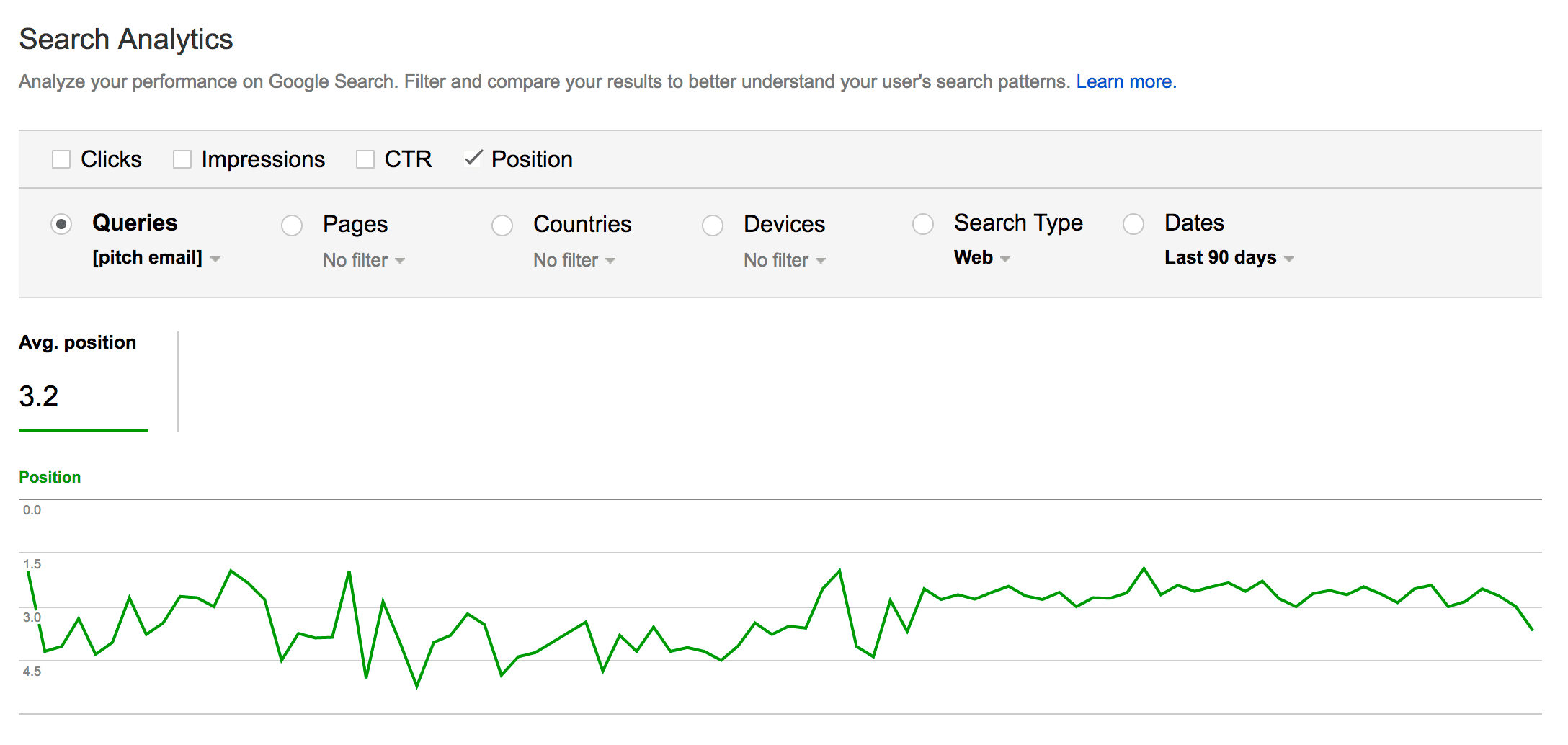
This chart shows the position in Google search results for an article I wrote with the keyword pitch email. And just like the chart says, if you search Google for that keyword*, you’ll see my article in the 2nd or 3rd position:
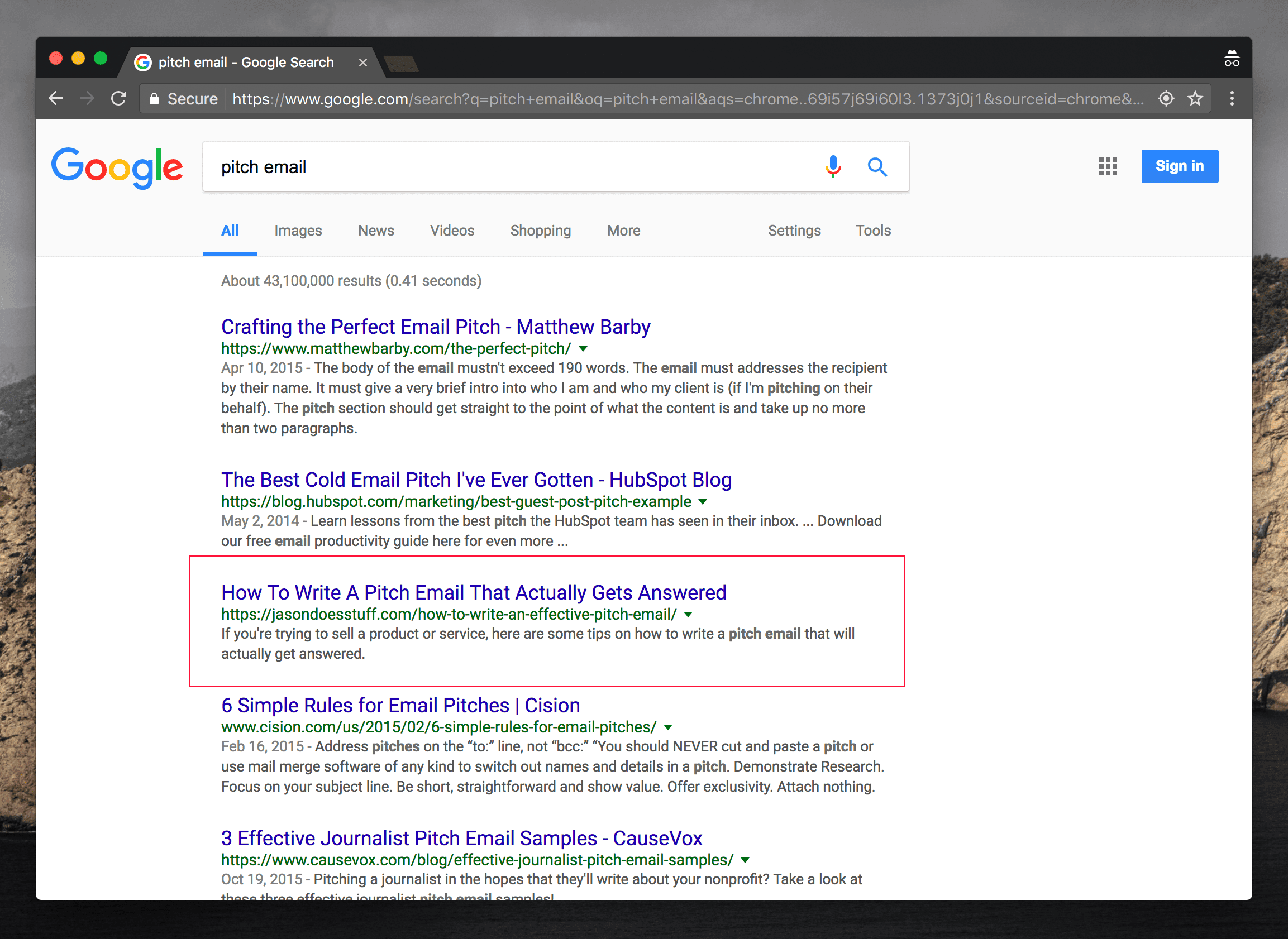
Note about searching Google for your own stuff: Make sure you use an incognito window in Google Chrome, or a separate browser where you aren’t logged in to to your Google accounts. Otherwise, your search results will show you your own stuff first, and not what other people (stranger danger!) see when they search.
This is what I use Google Search Console for 95% of the time. To see where my keywords are being positioned in Google and if they’re increasing.
As a heads-up, you are limited to 90-day history on searches, so you can’t see too far back in time (which is weird, considering most SEO tactics take 6-9 months to see results…)
I will have Matt chime in one last time with a cool trick for finding articles on your site that could use optimizing:
“When in the Search Analytics section, search by impressions and position. Sort by impressions, and find the content that gets a lot of impressions but the position is below 7. That means those article topics (keywords) get a lot of searches, but your content could be bumped up if you do some optimizing. These are content pieces on the cusp of ranking and getting big traffic boosts!”
Based on Matt’s trick, I found three articles I’ll be spending time trying to optimize and tracking the progress of over time (can you guess which one I want to rank higher for the most??)
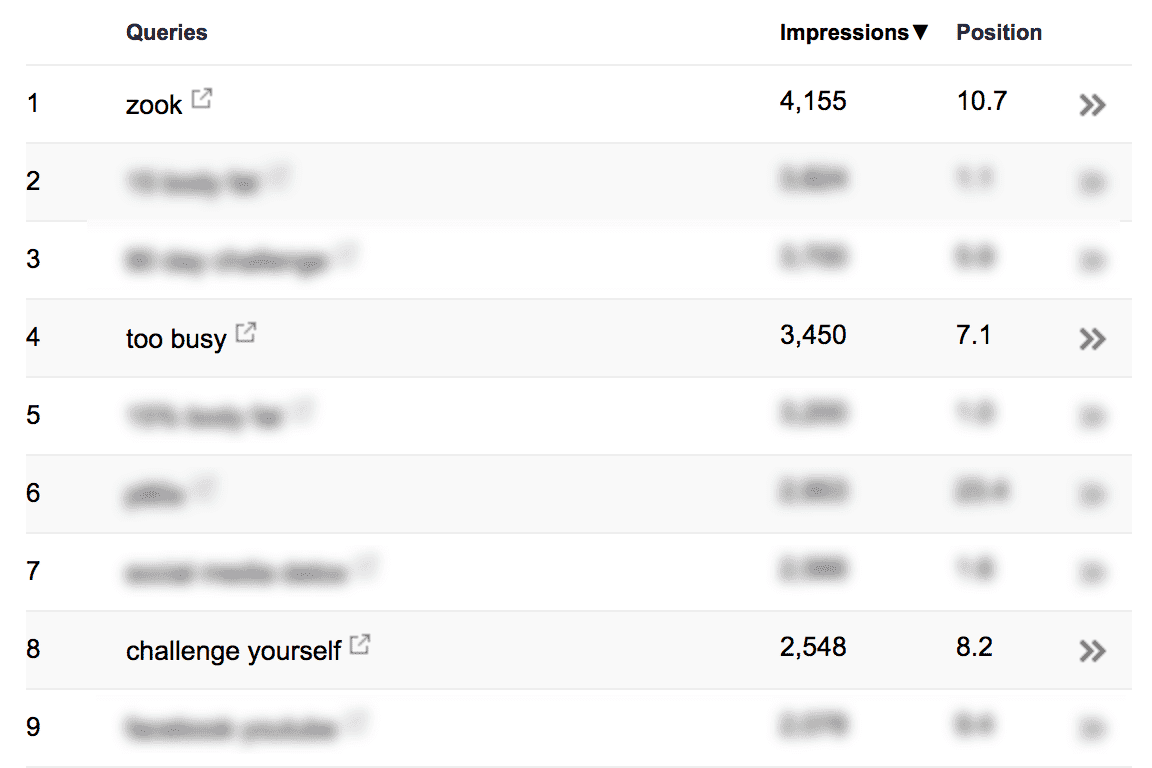
CONCLUSION:
Things To Avoid Doing That Will Hurt Your SEO/Organic Traffic
All right, let’s wrap things up, but let’s also talk about some important things to watch out for when it comes to SEO. These are a few things that will hurt your chances of increasing your organic visitors from Google. Which means, make sure you don’t do them!
Don’t use pop-ups on your website
For the love of all things holy, just stop using pop-ups. Pop-ups, whether they work are not, are annoying and Google is penalizing sites that use them and not showing those sites in search results as much.
Avoid bait-and-switch headlines/titles
This should be extremely obvious, but don’t write a headline for one thing, hoping to ride the coattails of some hot keyword, but then have an article about something unrelated. Google know what you’re trying to do here, and they don’t like it. Plus, if someone clicks a link to your site from Google, and immediately hits the back button, this is called pogo-sticking, and Google dislikes it.
Stop using heavy-loading plugins or bloated site builders
If you install a bloated WordPress theme (like Divi, for example), it can drastically slow down your website because it has to load all of its features. Google doesn’t like slow websites. Squarespace, unfortunately, is bloated too, even though I still recommend them to folks (something tells me Squarespace will figure out site optimization. They’re big time).
Try to avoid folks hitting your 404 page
In one of the (many) redesigns of JasonDoesStuff, I decided to remove 100+ old articles. I just deleted them. Right in the trash. What I didn’t think about is that those articles were old and had other sites linking to them that I didn’t know about. Luckily, and this is another reason to use Google Search Console, Google sent me an email about these now broken article URLs which were resulting in 404 page errors. Unluckily, I spent 8 hours redirecting all the broken URLs to the best pages on my site possible. So keep 404 errors in mind if you’re deleting old articles, and instead, maybe just leave the old articles alone (or spend time redoing them so they’re awesome).
You MUST improve your website’s mobile (responsive) experience
I could have devoted an entire section of this article to optimizing for mobile, but you should know this by now. If your site isn’t mobile friendly, Google is going to penalize you. Make your site mobile responsive. It’s worth the investment of time and money.
You have all my organic traffic growth and SEO strategies, what are you going to do with them?
Are you going to let your website continue to have great content buried in it? Or are you going to spend the time to set things up correctly?
If you want my action-taking advice:
Make a spreadsheet and list out the top 20-30 articles you think are most important on your site.
Do everything I’ve listed here to those articles.
Track your progress and check-in every couple months to see if you’re making progress and increasing organic traffic to your site.
Live your life and don’t worry about SEO.
I’ll say it one final time:
The best SEO strategy in the world is absolutely worthless if you aren’t writing useful and/or entertaining content.
Focus on that first, along with the foundation and structure of your articles.
Leave everything else to Google. K? K.
Join 12,000+ intentional business owners and get our Growing Steady newsletter every Monday where we share transparently about the latest projects we’re working on. You'll also get our Calm Creator Canva Whiteboard as a free download!













